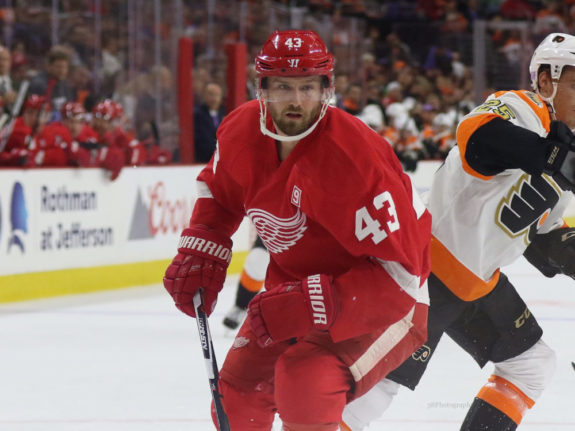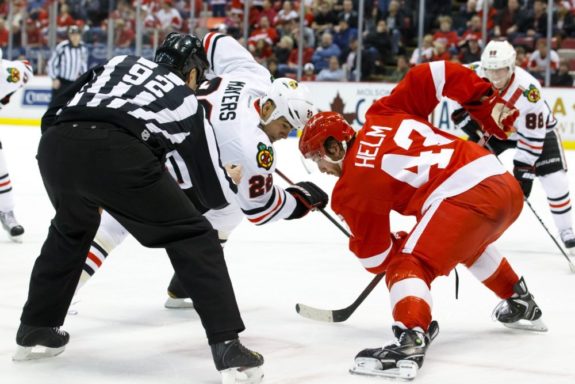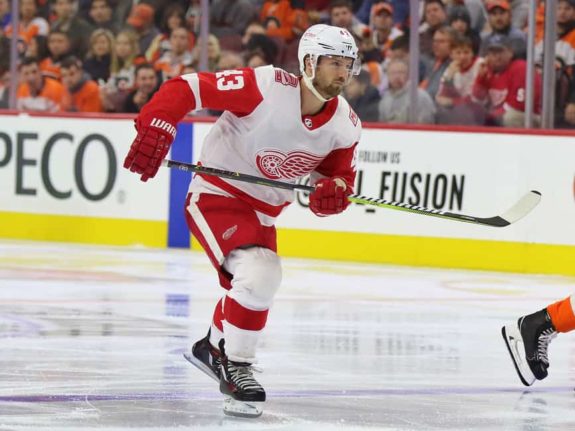July will mark the second anniversary of Darren Helm’s five-year contract to stay with the Detroit Red Wings, but organizational changes could mean he’s wrapping up his final season in Hockeytown.
Nearly two years ago, a 26-year-old Steven Stamkos highlighted the pending free agency class and was less than 48 hours away from hitting the market. Various teams cleared cap space for a potential pitch. Among them was Detroit, as general manager Ken Holland had just shipped off the final year of Pavel Datsyuk’s $7.5-million cap hit.
When the news broke that the superstar re-signed with the Tampa Bay Lightning, Holland seemed to scramble to put a Plan B into motion. Hours before the opening of free agency, he inked Helm to his current five-year, $19.25-million extension to remain in Detroit.
Related: Abdelkader’s Offseason Trade Value
Helm in Hockeytown
The general consensus among NHL analysts and insiders was that Helm’s deal was a bargain for what he could have received on the open market. But the 29-year-old’s skillset was one that could have easily been replaced by a cheaper, younger player with a shorter term. The periodic growing pains would have been manageable.
Instead, Helm was another case in the criticism of Holland being too loyal to his players. Holland committed $3.85 million of the salary cap for the next five seasons to the former fifth-round pick in 2005 (132nd overall). It came after new coach Jeff Blashill showed he didn’t have full trust in Helm.

In his first year under Jeff Blashill, Helm was seventh among forwards for ice time, ninth in team scoring and saw zero power-play time. He voiced some frustration about his fluctuating role.
The season prior—under Mike Babcock—Helm registered career highs in goals (15), points (33), faceoff percentage (53.7 percent) and ice time (15:50). He was also given power-play duty for the first time, where he added seven points (three goals and four assists) as a member of the team’s second unit.
Blashill turned Helm into a full-time winger, cut his ice time and repeatedly leaned on the more reliable offensive forwards in every situation. Helm’s production stayed relatively on track with 13 goals and 26 points through 77 games, but he said he didn’t feel fully respected with the lack of a defined role.
After the Extension
Following the extension, Blashill said he wanted his team to be fast and transition fast, noting that Helm was an important signing in that regard.
“He’s somebody who brings a couple of really good assets to your team,” Blashill told Helene St. James of the Detroit Free Press. “One, his competitiveness level is great. Two, it’s his speed.”
In training camp in 2016, Helm had told reporters that he and Blashill had opened up a better line of communication and that he is always willing to jump into different lineup spots, he just needed a better understanding of why.

“Sometimes I just didn’t feel like the message was relayed to me clearly,” Helm said. “I didn’t know if I was moving because I wasn’t playing well, or because I was doing things wrong. So we talked and we wanted to make a better line of communication between the two of us.”
In his second season, Blashill shifted Helm back to center, gave him a slight increase in ice time and used him in a more frequent power play role. He was limited to just 50 games, where he scored nine goals and 17 points as a handful of players that had taken a step back during Blashill’s second year with the team. Helm’s pace remained relatively consistent with his recent seasons, however.
Helm’s Future in Detroit
Helm’s role would change again in 2017-18, but it was a change more to a player’s liking. While he was put back on the wing, he owns 11 goals, 29 points and is averaging the second highest ice time of his career (15:35). He’s also just one of three Red Wings with a plus rating (plus-2).
With three games remaining, he’s just four points shy of tying his career high. The 31-year-old isn’t as fast as he was in his 20s and even though he’s no longer seeing power-play time, he’s still a reliable penalty killer with four shorthanded points (two goals and two assists).

The Red Wings have taken another step back as a team and with prospects including Evgeny Svechnikov and Michael Rasmussen vying for full-time spots next year, cap space and roster spots will be needed.
Helm’s bottom-six prowess makes him a trade chip for any team looking for reliable depth. Given his full no-trade clause (NTC), he would have to sign off should Holland look to move him. If Blashill and Holland were to approach him about a diminishing role for next season, he may view a trade as his best option. He could fetch a mid-to-late-round draft pick in return, but it’s the much-needed cap relief that would do Detroit best.
His NTC would also give him the ability to choose his destination based on interested teams. With an aura of uncertainty around Hockeytown, Helm’s value and still-fluctuating role could spell the end of his tenure in Detroit.